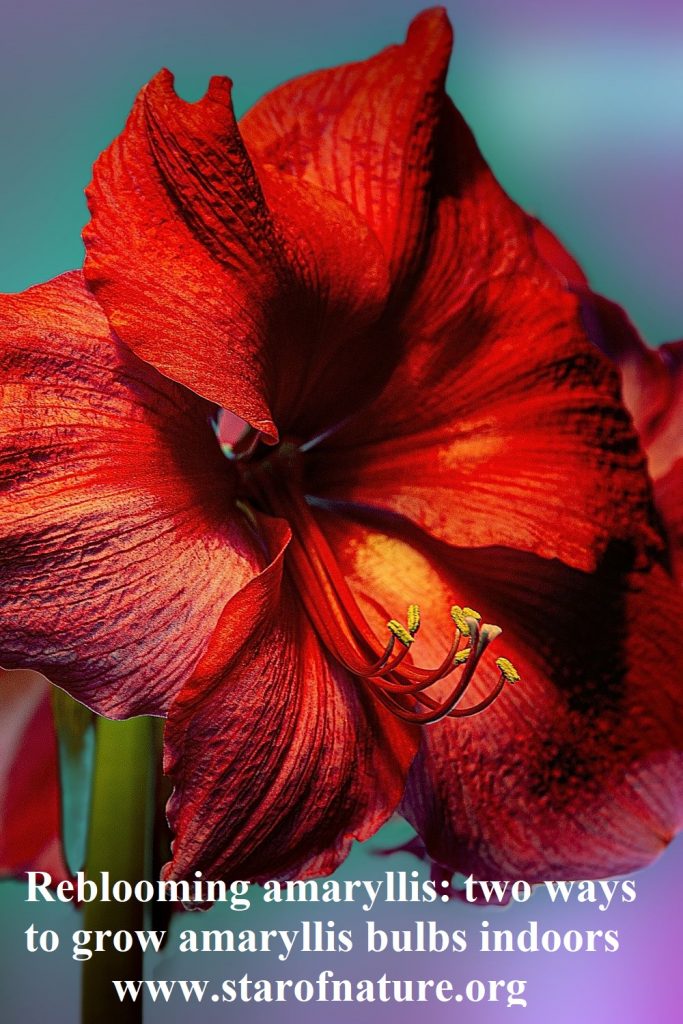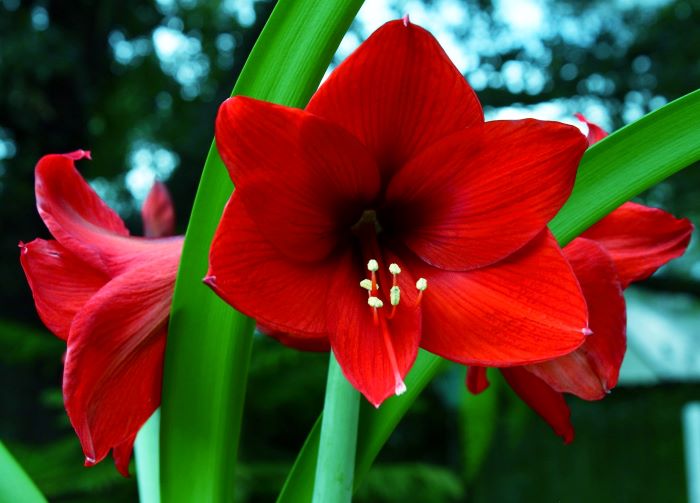Reblooming Amaryllis: Two Ways to Grow Amaryllis Bulbs Indoors
Reblooming amaryllis is not at all difficult. With very little effort amaryllis bulbs can be grown indoors to produce spectacular flowers year after year. Some of my bulbs are more than 10 years old and still flower beautifully. Amaryllis is definitely not just for Christmas.
Amaryllis: meaning
The name amaryllis was given to the plants that later became part of the Amaryllidaceae family by Carl Linnaeus (1707-1778). It was a typical name of a beautiful country girl, nymph or shepherdess in ancient Greek and Roman poetry. A ‘lovely Amaryllis’ is a character of pastoral and love poems of Theocritus, Virgil and Ovid.
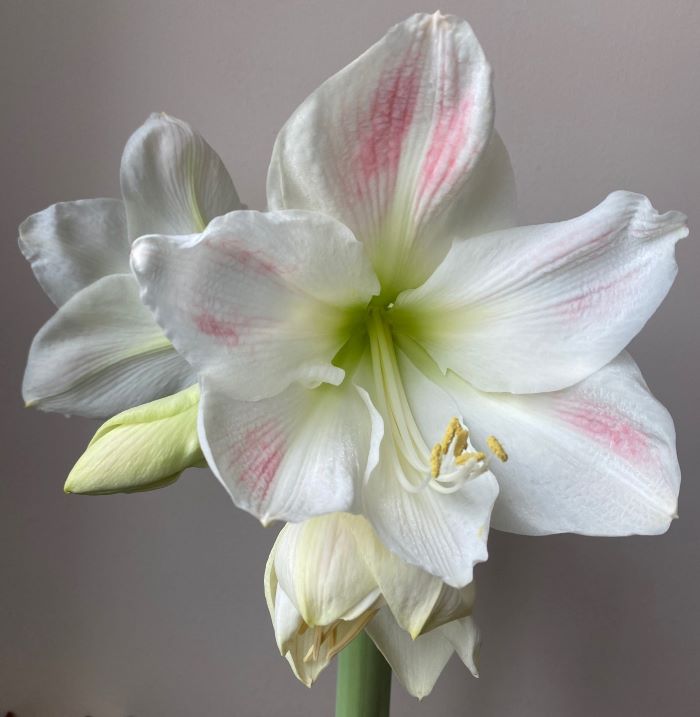
Amaryllis and Hippeastrum
A degree of confusion surrounds a botanical term ‘amaryllis’. In 1954 an international congress of botanists recommended that the name ‘amaryllis’ should be reserved exclusively for an African species, Amaryllis belladona. It is a beautiful native of South Africa that is now naturalised in Southern Europe. It has large, pink, lily-like flowers that are displayed on tall stalks before the leaves emerge.
At the same time the American species of the same family were re-classed as Hippeastrum. It is the members of this genus that are most commonly grown today as house plants and sold as large bulbs in autumn. The name ‘amaryllis’ is of course more attractive and memorable than ‘hippeastrum’, and so it is still used today for these much loved flowers.
Amaryllis in nature
All varieties of amaryllis (Hippeastrum) are warm climate plants, native to the tropical regions of South America. Most come form Brazil, but some are from Argentina, Mexico, Peru and the Caribbean. In nature amaryllis grow on plains, high altitude meadows and mountain sides that get rain in spring and dry out in the summer.
During the period of spring rains amaryllis flower together with other bulbs and ephemeral spring plants. And during the dry period, when the hot sun turns their environment into a desert, the bulbs go dormant.
Amaryllis are perfectly adapted to such conditions. They quickly revive and produce flowers, when rains arrive. Their ability to grow flowers at impressive speed is one of their greatest attractions.
There are many species of wild hippeastrum, and modern decorative cultivars are hybrids of different wild South-American varieties.
Because of their tropical origin, amaryllis are well suited to growing indoors in warm conditions. They were first brought to Europe in the 16th century, and the breeding of decorative hybrids started at the beginning of the 19th century.
Over two centuries growers produced a great range of large-flowered cultivars available today. Amaryllis come in numerous shades of red, pink and white, and there are double-flowered and mixed colour varieties, with different stripes and edging on petals.
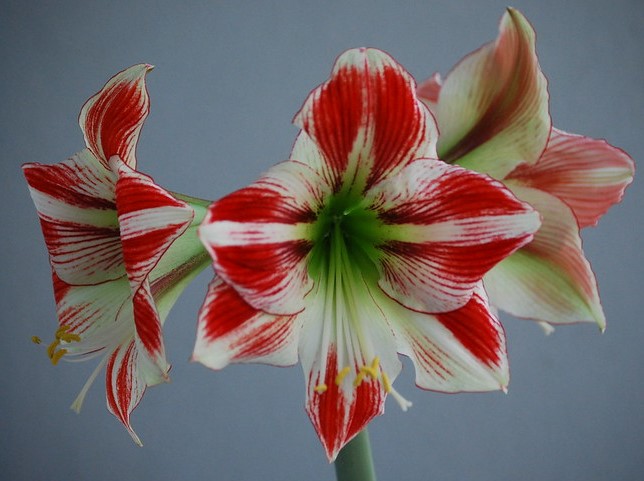
Two ways of growing amaryllis bulbs indoors
1. Growing amaryllis without full dormancy
It is possible to grow amaryllis indoors without a period of full dormancy. With this method the bulbs are planted in pots and put on a windowsill. The pots are watered throughout the year, as the soil becomes dry. Amaryllis will flower, depending on the variety, in September-November or March-May.
After flowering reduce the watering, and after 6 weeks either carefully replant the bulbs or change the top layer of their soil (see more on soil below). If organic fertilizer is regularly used, it is not necessary to replant the bulbs every year. It can be done every second or third year.
When replanting, slightly loosen the root ball and remove some soil to free the space for new soil. Keep the roots themselves intact. Don’t cut them off unless they are damaged, because this will weaken the plants.
Use the same or a new pot – it should be only slightly wider than the bulb (see more on choosing the pot and planting the bulbs below).
After replanting resume watering and continue as normal. Add organic fertilizer every 1-2 weeks.
This is probably the easiest way of growing amaryllis. It’s main drawback is that flowering cannot be timed for a particular date.
2. Growing amaryllis to flower in winter or early spring
To have amaryllis flowering definitely in winter or early spring, the second method can be used.
Plant the bulbs in autumn and put in the warmest place in the house (20-30C), not necessarily close to a window. During this time no watering is necessary, until the flower stalk becomes visible at the top of the bulb.
With this method the flower appears before the leaves, contributing to an exotic look of amaryllis.
Once the flower stalk has emerged, put the pots on a windowsill and water, ideally with slightly warm water (see more on watering below). Continue watering whenever the soil is dry until amaryllis flowers.
Once they flower, they can be moved somewhere where they can be seen and used for decoration, even if this is away from windows. It is fine to keep them away from light for a couple of weeks.
Ideally the room where they are displayed should not be too hot. The cooler is the air, the longer they will flower.
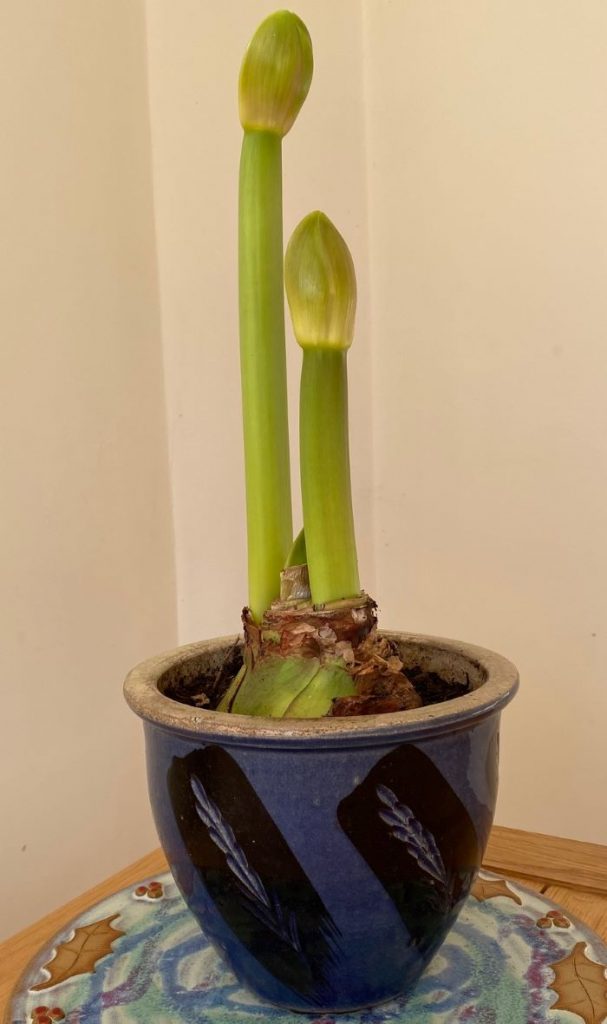
Reblooming amaryllis: caring for bulbs after flowering
After flowering put amaryllis on a sunny windowsill again and keep it there in spring and summer. Amaryllis can grow outside in the garden in the summer, but they easily fall victim to slugs that damage leaves and weaken the plants.
After flowering the bulbs will develop leaves. Continue watering them well throughout the entire growing season.
Add organic fertilizer every 1-2 weeks.
Reblooming amaryllis: caring for bulbs in late summer and early autumn
Reduce watering in August, and put the pots in storage in late August or September. Keep them in a dark frost-free place where leaves will die off. The bulbs are tender and should not be exposed to frost.
After a period of dormancy, either replant the bulbs or change the top layer of their soil. As mentioned already, it is not essential to replant the bulbs every year – this can be done every second or third year. It is, however, a good idea the change the top layer of their soil (see more on soil below).
Bring the pots to a warm room. Water sparingly intill the flower stalk emerges (see more on watering below).
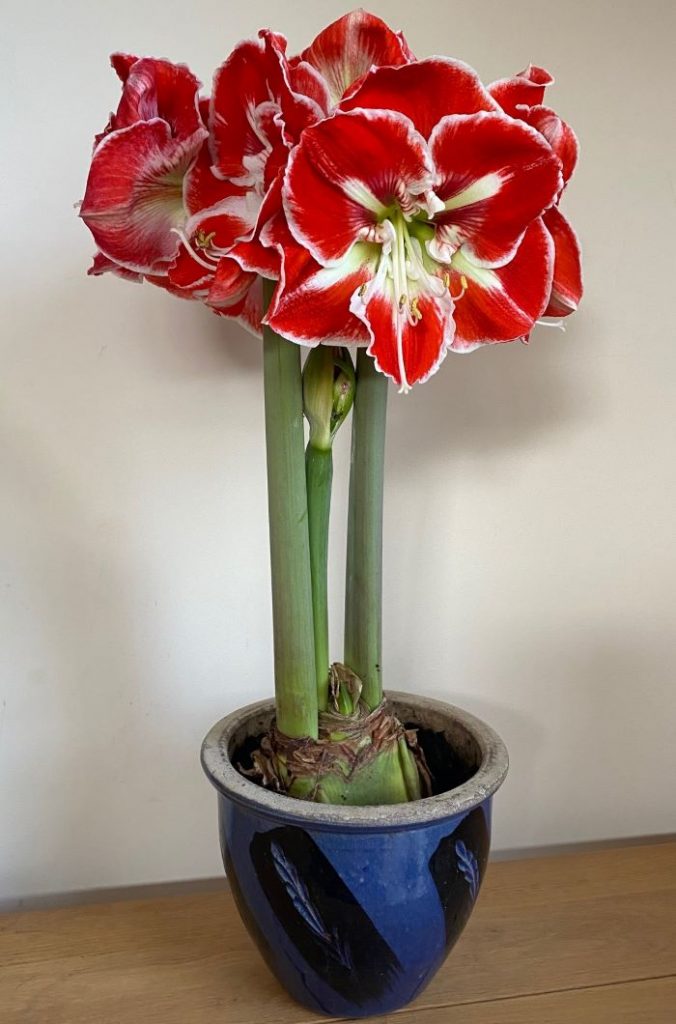
Reblooming amaryllis: timing dormancy
The exact time of dormancy depends on when the bulbs are expected to flower again – they will flower about 5-6 weeks after replanting.
Amaryllis for Christmas
To flower at Christmas, amaryllis needs to be dormant from the end of the summer and until the end of October or early November.
When timing the bulbs dormancy, it is important to give some thought to their exposure to light. Amaryllis needs light to produce strong flower stalks. And so unless you have a really bright place to grow them, such as a warm conservatory or a south-facing window, the flower stalks may grow too tall and weak in the darkest months of the year, November and December. It therefore may be preferable not to attempt ambitious mid-winter flowering, but delay it until there is more light.
Amaryllis for Valentine’s day and Easter
Bulbs can be put into storage at the end of September and woken up in January or February.
Amaryllis bulbs started into growth in January will flower in February (for Valentine’s day?), and those started into growth in February will flower in March (for Easter?).
It is important to remember, however, that flowering cannot be delayed indefinitely. If the bulbs are ‘forgotten’ in the garage beyond late February or early March, they will produce weak flower stalks in the darkness and eventually die.
Due to longer days and more sunlight, bulbs grown in late winter and early spring will produce stronger flowers. And this is still the time when it is cold outside and flowers indoors are very desirable.
To ensure that the flower stalk grows straight, turn the pot frequently, so that different sides of the plant are exposed to the light.
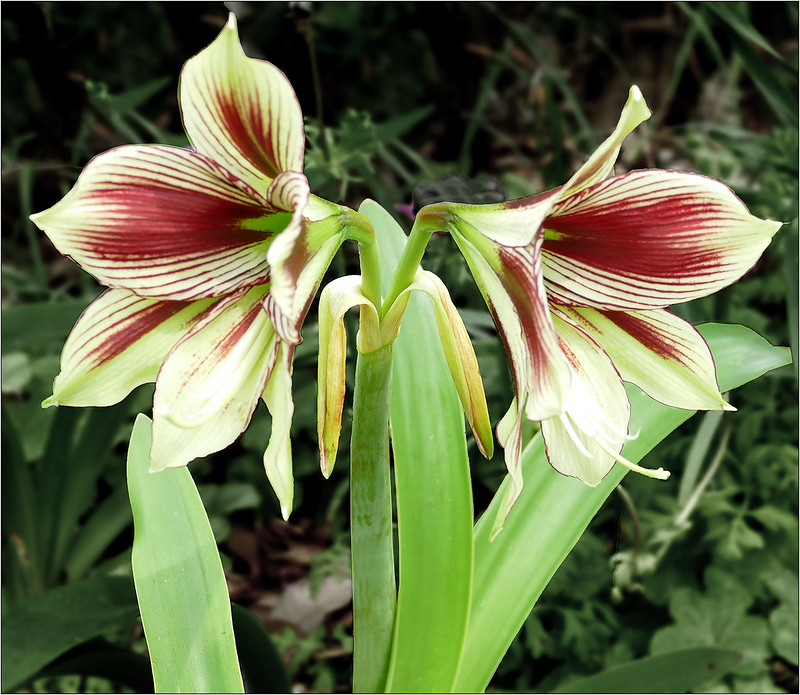
Watering amaryllis
It is important to water sparingly when amaryllis bulbs emerge from dormancy. The best way to do this is to keep the pots in trays and add water to trays, instead of watering the soil directly. Do this until the flower stalk is about 20cm tall.
If you water the soil directly from the start, the flower stalk may not emerge or will be overwhelmed by leaves. Once it is growing well, however, it is fine water the soil directly.
It is also best to let the compost dry completely between waterings. And the bulbs should not sit in water for long periods of time because this can make them rot.
Light requirements: how much sun does amaryllis need?
Amaryllis prefer full sun when they are growing. The more sunlight they get and the more leaves they develop in the summer, the better they will flower. Keep them in the sun in the summer and water well.
Two keys to success with reblooming amaryllis: width of pots and planting depth
Amaryllis have two very important requirements: they don’t like large pots and they like to be planted at the correct depth. A wrong choice of a pot and a wrong planting depth are the most common reasons why amaryllis don’t flower.
So here are some of the most important rules to follow when planting or re-planting amaryllis:
1. The bulbs need to be planted in pots that are only slightly larger than their circumference. The distance between the bulb and the sides of a pot should be 2-3cm. The pots should closely match the size of the bulb’s roots. And if unsure, it is better to use a smaller, rather than a larger pot.
If the pot is too large, the bulbs will produce lots of leaves and offsets (young bulbs), but will not flower.
2. The top third of the bulb needs to be exposed above the soil. This is natural for amaryllis, and the bulbs planted too deep will not flower.
3. When planting make sure not to damage the roots. Even though the bulbs are sometimes sold without roots, the plants react badly to the loss of their roots. Their roots do not die off completely during dormancy.
4. Add stones or pieces of broken pottery at the bottom of the pot to ensure good drainage.
Soil for growing amaryllis
For success with reblooming amaryllis, ideally use the following mixture:
- 2 parts of crumbly, rich garden soil
- 1 part leaf mould
- 1 part well rotted manure
- 1 part sand.
Is amaryllis poisonous?
All members of the amaryllis family are poisonous. They should not be in contact with eyes and they certainly should not be eaten. It is only rarely, however, that they cause skin irritation.
Image credits: featured image – Amaryllis by A Yee, Amaryllis ‘Papilio’ by Surely Shirly, pin – Amaryllis by Angelo Brathot
Update
This year my amaryllis were better than ever. Almost all bulbs, even the smallest, produced two flower stalks. The flowers emerged before leaves, and the leaves stayed small and neat until the end of flowering. I would therefore like to describe how I grew them last year, hoping that this will be useful to readers.
After the bulbs finished flowering, I put them on a windowsill that gets sun from early morning and until about 1pm. When the curtain is partially drawn, it gets really quite hot. I watered them once a week, leaving water in trays in which the pots were positioned. The water stayed in trays for another day or two. Once a week I added ready-made organic fertilizer that I measured and pored over the compost.
In August I put the pots with plants out into the garden. This was because I was going away for two weeks and the plants had to depend on rain for their water. In late September I moved them in a cold, frost-fee garage. This was all – I did not replant. What can be easier and more enjoyable? I think sunny and hot conditions during the summer made a real difference.
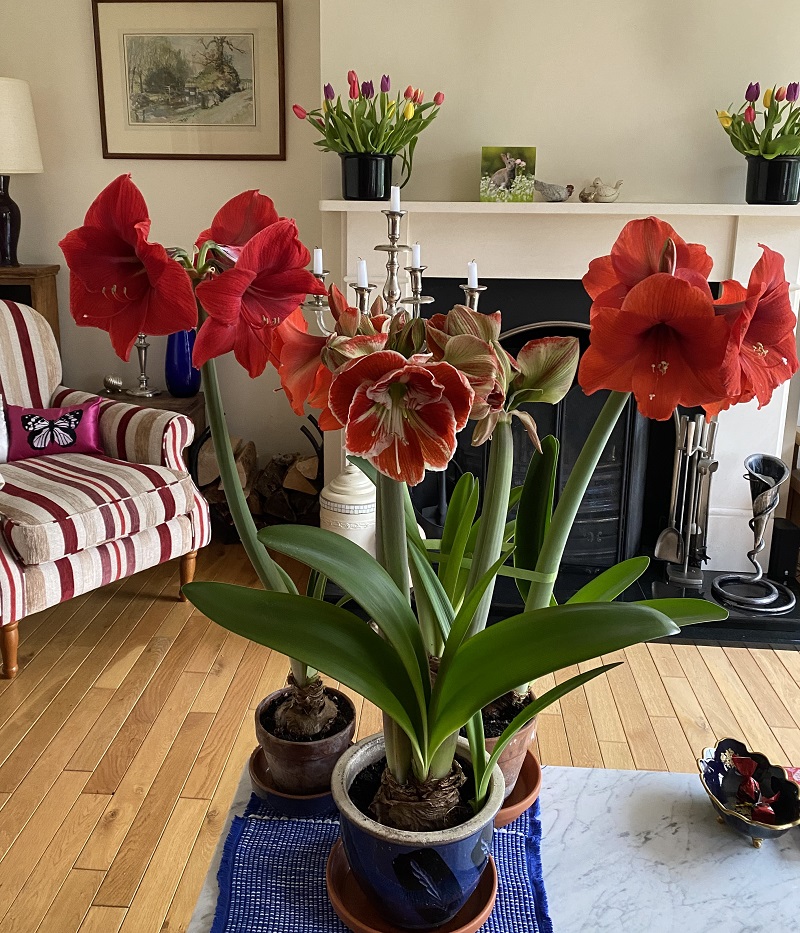
Posts related to ‘Reblooming Amaryllis: Two Ways to Grow Amaryllis Bulbs Indoors’
Growing Lily-of-the-valley in Winter
Indoor Garden Ideas: Growing Microgreens on a Windowsill
Sweet Violet (Viola Odorata) and Parma Violet: How to Grow Forgotten Treasures
Autumn crocus (Colchicum autumnale) – a Star of Early Autumn
Pin ‘Reblooming Amaryllis: Two Ways to Grow Amaryllis Bulbs Indoors’ for later
